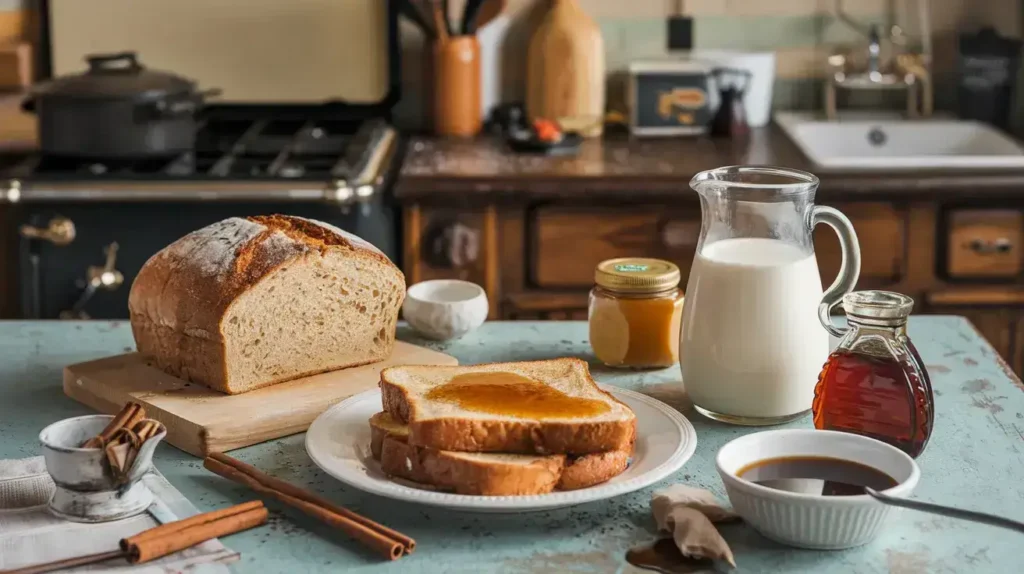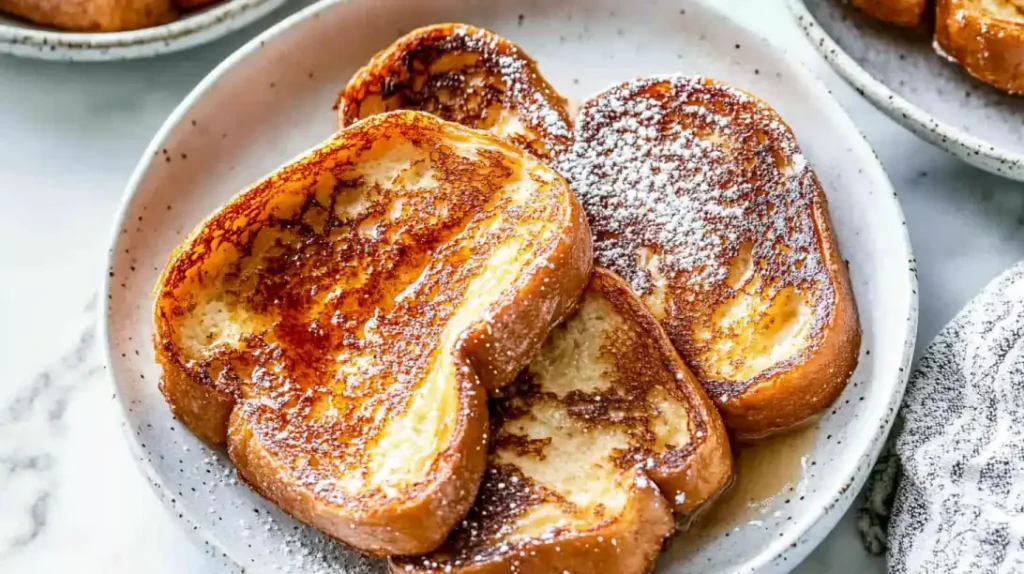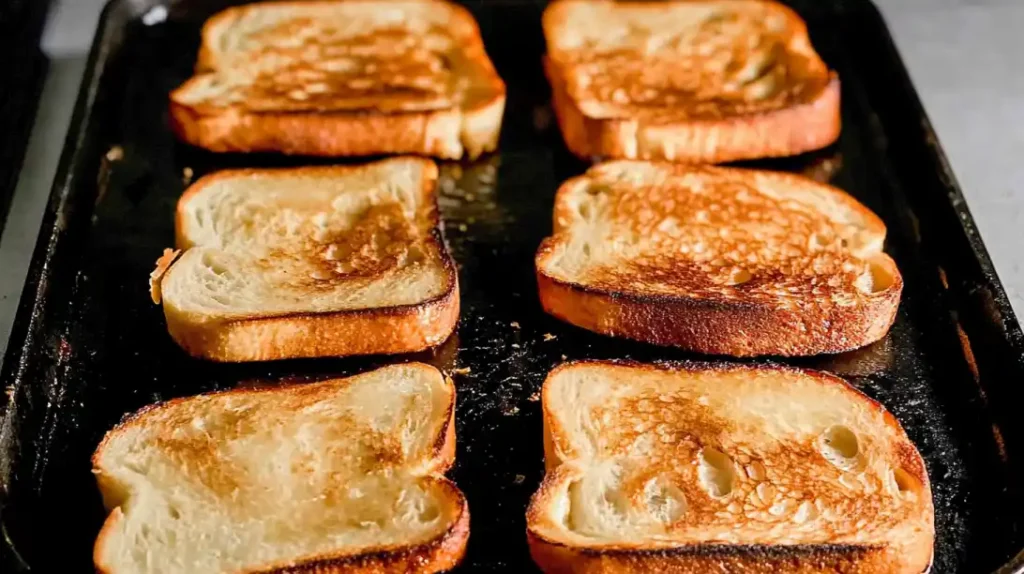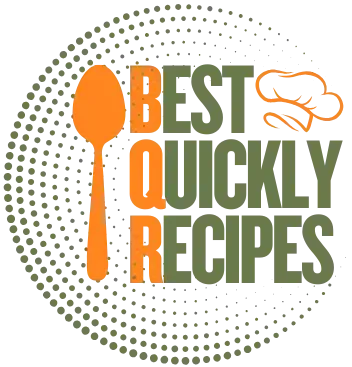Table of contents
The Origins of French Toast
Historical Background
The origins of French toast trace back to ancient Roman times when leftover bread was soaked in a mixture of milk and eggs before being cooked. This thrifty dish evolved through centuries, adapting to local ingredients and preferences. For example, check out how regional dishes like breakfast lasagna showcase similar culinary ingenuity.
Over the centuries, this simple and efficient recipe spread across Europe and beyond, evolving into variations that reflected local ingredients and tastes.
Variations Across Cultures
- In France, the dish is known as pain perdu, meaning “lost bread,” emphasizing its purpose in salvaging unused bread.
- In the United States, French toast often includes sweet additions like cinnamon, vanilla, and powdered sugar, making it more of a dessert-like breakfast.
- In Asia, savory versions are sometimes preferred, with spices and toppings that cater to local palates.
These variations underscore the flexibility of French toast as a canvas for flavor experimentation.
For a decadent twist, you might want to explore cinnamon roll French toast.
Ingredients in Traditional French Toast Recipes
Core Ingredients: Eggs, Milk, and Bread
At its heart, French toast requires just three ingredients:
- Bread – Preferably slightly stale, as it absorbs the mixture without falling apart.
- Eggs – Provide structure and richness to the coating.
- Milk – Adds moisture and creates a creamy consistency.
These core ingredients form the foundation of the dish, allowing for both simplicity and versatility.
Optional Additions
To enhance the flavor, additional ingredients are often included:
- Sweeteners like sugar or honey.
- Flavorings like vanilla extract.
- Spices like cinnamon or nutmeg.
Spices like cinnamon and nutmeg, or sweeteners like sugar and vanilla, are popular but optional. Experiment with different variations using recipes like low-sugar desserts to suit your dietary preferences.
The Role of Cinnamon in French Toast
Flavor Enhancement
Cinnamon adds a warm, sweet spiciness that complements the creamy texture of French toast. If you’re exploring spiced dishes, consider the broader culinary applications of cinnamon in recipes like churro cheesecake.
Cultural and Regional Preferences
Not all versions of French toast include cinnamon. In France, for example, pain perdu is often made without it, focusing on the natural sweetness of the bread and custard mixture. However, in North America, cinnamon has become almost synonymous with French toast, reflecting local preferences for spiced, dessert-like breakfasts.
In other parts of the world, the inclusion of cinnamon depends on the cultural context and the flavors traditionally favored in the region. Some Asian recipes lean toward savory versions that omit cinnamon entirely, while certain Middle Eastern-inspired variations might include it alongside cardamom or other regional spices.
While cinnamon is not a mandatory ingredient in French toast, it is a beloved addition in many recipes, particularly in Western cuisines. Its inclusion depends on cultural traditions and individual tastes, showcasing the dish’s adaptability and global appeal. Whether you prefer your French toast with or without cinnamon, its versatility ensures it remains a breakfast favorite around the world.
How Cinnamon Alters the Taste Profile
Sweetness and Spiciness Blend
Cinnamon’s unique flavor profile combines a warm sweetness with a subtle spiciness, making it a standout addition to French toast. When added to the egg and milk mixture, cinnamon infuses the bread with its aromatic notes, enhancing the overall taste. The sweetness from cinnamon complements sugar or syrup toppings, while its spiciness adds depth, making each bite more complex and satisfying.
Balancing with Other Ingredients
Cinnamon works harmoniously with other common ingredients in French toast:
- Vanilla extract enhances its sweetness.
- Nutmeg or other spices amplify its warm notes.
- Sugar balances the spice, ensuring a pleasant, rounded flavor.
This balance elevates French toast from a simple dish to a flavorful breakfast treat. However, moderation is key, as too much cinnamon can overpower the other ingredients.

Regional Variations in French Toast Recipes
French vs. American Styles
- French Style: Known as pain perdu, traditional French toast in France is often minimalist. It focuses on a custard-like texture and subtle flavors, rarely including cinnamon. Powdered sugar or fresh fruit is a common topping, emphasizing simplicity.
- American Style: In the United States, cinnamon is a staple in French toast recipes. The dish often includes vanilla, sugar, and spices, creating a dessert-like breakfast. Toppings like maple syrup, whipped cream, and fruit are common, amplifying the sweetness.

Other Global Twists
- Asian Variations: French toast in many Asian countries leans savory, with additions like soy sauce or scallions, often omitting cinnamon entirely.
- Middle Eastern Influence: Recipes inspired by Middle Eastern cuisine might incorporate spices like cardamom or saffron alongside cinnamon for a more exotic flavor profile.
- Latin American Style: Some variations feature dulce de leche or condensed milk, with or without cinnamon, depending on local preferences.
These variations highlight how cinnamon’s use—or absence—can significantly influence the dish’s flavor and cultural identity.
Cinnamon-Free French Toast Options
Alternative Flavorings
For those who prefer French toast without cinnamon or have dietary restrictions, several alternative flavorings can create equally delicious results:
- Vanilla Extract: Adds a rich, sweet aroma.
- Citrus Zest: Lemon or orange zest provides a refreshing tang.
- Almond Extract: Delivers a nutty flavor that pairs well with sweet toppings.
These options allow for a unique twist while maintaining the dish’s essence.
Popular Substitutes for Cinnamon
If you want to replace cinnamon with a similar spice, consider these substitutes:
- Nutmeg: Offers warm, earthy tones with a slightly nutty flavor.
- Clove: Provides a bolder, spicier kick, often used sparingly.
- Allspice: Combines the flavors of cinnamon, nutmeg, and cloves in one.
These substitutes can mimic cinnamon’s warming qualities while introducing new dimensions to the flavor.
Cinnamon is a versatile and beloved addition to French toast, but it’s not essential. Whether you prefer a cinnamon-spiced version, a minimalist French-style approach, or a creative cinnamon-free twist, French toast remains an adaptable dish that caters to diverse tastes and traditions.
Nutritional Aspects of Adding Cinnamon
Health Benefits of Cinnamon
Cinnamon is not just a flavorful addition to French toast; it also offers several health benefits:
Antioxidant Properties
Cinnamon is rich in antioxidants, which help protect the body from oxidative stress and damage caused by free radicals. These properties may contribute to reducing inflammation and boosting overall health.
Blood Sugar Regulation Benefits
Cinnamon is known to have compounds that can help regulate blood sugar levels by improving insulin sensitivity. This makes it a helpful addition for people looking to moderate their glucose levels while enjoying a sweet breakfast like French toast.
Calorie Considerations
Adding cinnamon to French toast has minimal impact on the calorie count. Unlike sugar or syrup, cinnamon adds flavor without contributing significant calories, making it a healthier way to enhance sweetness and spice in the dish.
Is French Toast Still Healthy Without Cinnamon?
Nutritional Balance
French toast can remain a balanced meal without cinnamon, especially if you focus on using wholesome ingredients. Whole-grain bread, low-fat milk, and natural sweeteners like honey or maple syrup can make a healthier version without compromising flavor.
Lower Sugar Variants
For those avoiding sugar, a cinnamon-free French toast can still shine with alternative toppings like fresh fruit, yogurt, or a sprinkle of powdered sugar. These options keep the dish light and nutritious while offering a range of flavors.

How to Make Classic French Toast With Cinnamon
Step-by-Step Recipe
Ingredients:
- 4 slices of bread (preferably slightly stale)
- 2 eggs
- 1/2 cup milk
- 1 tsp cinnamon
- 1 tsp vanilla extract
- 1 tbsp sugar (optional)
- Butter or oil for cooking
Instructions:
- In a shallow bowl, whisk together eggs, milk, cinnamon, vanilla extract, and sugar until well combined.
- Heat a skillet over medium heat and lightly grease with butter or oil.
- Dip each slice of bread into the egg mixture, ensuring it’s well-coated but not overly soggy.
- Place the coated bread on the skillet and cook for 2-3 minutes per side, or until golden brown.
- Serve warm with toppings like maple syrup, powdered sugar, or fresh fruit.

Pro Tips for Flavor Enhancement
- Even Coating: Make sure to soak the bread evenly to prevent uneven cooking.
- Use Fresh Cinnamon: Ground cinnamon loses potency over time; use fresh for the best flavor.
- Experiment with Toppings: Add whipped cream, nuts, or even a drizzle of honey for extra indulgence.
Alternative Recipes Without Cinnamon
Vanilla-Infused French Toast
Ingredients: Replace cinnamon with an extra splash of vanilla extract. Top with fresh berries and powdered sugar for a light and fragrant twist.
Steps: Follow the classic recipe but omit cinnamon and emphasize the vanilla flavor. Add a touch of nutmeg for warmth if desired.
Lemon-Zest French Toast Recipes
Ingredients: Add 1 tsp of lemon zest to the egg mixture and serve with a dusting of powdered sugar and a dollop of Greek yogurt.
Steps: Mix lemon zest into the custard base, cook as usual, and garnish with toppings that enhance the citrusy freshness.
French toast is a versatile dish that welcomes creative variations, whether with cinnamon or without. With its potential health benefits and adaptability, this breakfast classic remains a favorite across cultures and palates.
Common Mistakes When Using Cinnamon
Overpowering the Flavor
Cinnamon’s warm and spicy taste can enhance French toast, but using too much can overpower other flavors in the dish. A balanced amount is key to complementing the sweetness and richness of the custard mixture without overwhelming the palate.
Using too much cinnamon can overwhelm the dish. Learn how to balance flavors effectively with pro tips from articles like mastering easy dinner recipes.
Uneven Mixing
Failing to mix cinnamon thoroughly into the custard can lead to clumps, resulting in uneven flavor distribution. To avoid this, whisk the egg mixture well or dissolve cinnamon in a small amount of liquid (like milk) before adding it to the main mixture.
Frequently Asked Questions (FAQs)
Is French toast supposed to have cinnamon?
No, cinnamon is not a mandatory ingredient in French toast, but it is a popular addition in many recipes, especially in the United States. Its inclusion depends on personal taste and regional preferences.
What does French toast contain?
Traditional French toast is made with bread, eggs, milk, and optional sweeteners like sugar or vanilla. Variations may include spices like cinnamon, nutmeg, or toppings like syrup, fruit, or powdered sugar.
What is the most common mistake in making French toast?
The most common mistakes include:
- Using overly fresh bread, which can become soggy.
- Over-soaking the bread in the custard mixture.
- Cooking on too high heat, leading to burnt outsides and undercooked insides.
Over-soaking bread or burning it during cooking are frequent pitfalls. For more, see how to prevent soggy French toast.
Does Cinnamon Toast Crunch actually have cinnamon?
Yes, Cinnamon Toast Crunch cereal contains real cinnamon, which gives it its signature flavor. It is blended with sugar and other ingredients to create its iconic sweet and spicy taste.
Conclusion: Does French Toast Contain Cinnamon?
Summary of Cinnamon’s Role
While cinnamon is not a required ingredient in French toast, it is a popular choice for enhancing flavor, particularly in American recipes. Its warm and spicy notes complement the dish’s sweetness, making it a staple in many variations.
Encouragement to Experiment
French toast is a versatile dish that allows for endless creativity. Whether you include cinnamon or opt for alternative flavors, let your palate guide you. For more inspiration, check out the ultimate guide to potato tacos.

